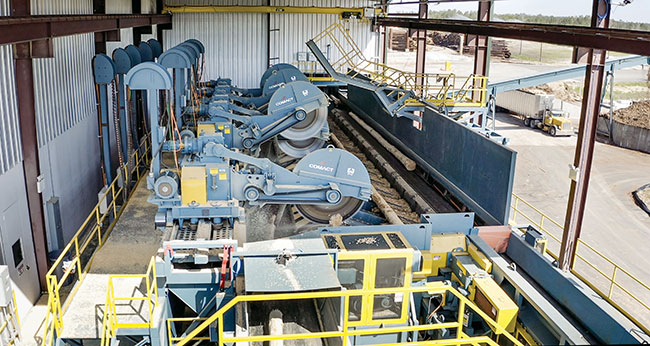
Features
Equipment
Sawmilling
Saw Filing 101: A world of chaos
If it cuts wood at your facility, make sure you have it ordered. Don’t wait until you need it because your supplier may be waiting on their delivery as well.
May 29, 2023 By Paul Smith
 Since the trend has moved to narrower kerf and thinner plate, your mill better have plenty on-hand and on-order. Photo courtesy of BID Group.
Since the trend has moved to narrower kerf and thinner plate, your mill better have plenty on-hand and on-order. Photo courtesy of BID Group. No one in business or even at home likes to run out of something, especially something we consider critical. Well today, this happens more often than not and it’s not always any one person’s fault.
When it comes to operating a sawmill, I’ve always said it’s called a SAWmill for a reason. That reason is because, to operate at all, one has to have saws and since the trend has moved to narrower kerf and thinner plate, your mill better have plenty on-hand and on-order!
So whose responsibility is it to make sure the mill has plenty of saws and why has it become an issue? When I started Smith Sawmill Service over 30 years ago, in Southern U.S., saw plates lasted months, even years at some mills. These saw plates were thicker, kerf was wider, mills didn’t run 24/7, and most mills weren’t curve sawing or running the high production of today’s mills.
Manufacturing changed to meet the needs of mills when curve sawing and thin kerf technology came on the scene and saws were usually delivered to the mills in six to eight weeks. As mills added shifts and ramped up production, we in the industry observed delivery dates fluctuate. Ten to 12 weeks was a long lead time in most situations, until approximately two years ago.
The world of chaos caused by COVID-19 and nationwide shutdowns has led to disruptions that we are experiencing today and will probably have to deal with for years.
We are a smart industry, and we’ve maneuvered through log scarcity, natural disasters, endangered species and of course politics, but the international supply chain and logistics interruptions we’ve had to endure have changed how we plan, purchase, operate and, yes, even overstock the items we deem critical. Today’s lead times aren’t given in weeks but rather months. Machinery dates are out this year and in 2024, and saws can be as well. So planning has become everyone’s responsibility, especially the head filer. Planning for normal wear and tear, unscheduled changes, and saw failure has always been built into how many sets of saws a mill had. Now that same filer has to plan for logistical chaos as well – steel shortages, shipping shortfalls, labour shortages, and supply chain disruptions. Filers are forced to make their existing saws stay in production, many times beyond their best performance.
Today’s head filer has to work closely with management and their vendors to make sure saw inventory is sufficient, not only at the mill, but in the storeroom, as well as at the manufacturers and suppliers. The head filer and the mills’ purchasing department should be making sure that they have scheduled saw deliveries for all operations: head saws, trimmers, edgers, gangs. If it cuts wood at your facility, make sure you have it ordered. Don’t wait until you need it because your supplier may be waiting on their delivery as well. A good supplier is working with you to make sure they have raw plates, tips, saws in process and some saws ready to go. But remember, like everyone else, their supply chain has been affected too!
What is a good number? How do you determine how many saws to order? Work together, look at data, and in case your mill is looking at any line changes that will affect your saw design, get that info to your supplier early in the process – but that’s a whole different article. Today’s planning is tomorrow’s smooth sawing!
 Paul Smith is a saw filing consultant and founder of Smith Sawmill Service, now part of BID Group. You can reach him at Paul.Smith@bidgroup.ca.
Paul Smith is a saw filing consultant and founder of Smith Sawmill Service, now part of BID Group. You can reach him at Paul.Smith@bidgroup.ca.
This article is part of CFI’s 2023 File Week. Find the File Week landing page here.
Print this page